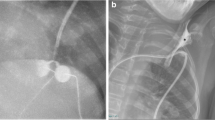Abstract
Purpose
Evaluate in a prospective randomized study carbon dioxide (CO2) gas compared to iodinated contrast agent for image-guided placement of peripherally inserted central venous catheters (PICCs).
Methods
The upper-arm approach to the central vein was used for placement of PICCs in 74 patients requiring intermediate or long-term central venous access. Fluoroscopy was used to obtain venous access during peripheral injection of CO2 (n = 41) or low osmolar contrast material (Omnipaque 240 mgI/ml) (n = 33).
Results
Placement of PICCs was accomplished in 88% of the CO2 group and in 100% of the contrast group, with a mean venipuncture of two in both groups. Venous access was unsuccessful in five patients with CO2 due to a small vein, venous spasm, or technical failure. The mean and range of procedure times were 22.8 min (13–64 min) with CO2 and 23.2 min (12–60 min) with contrast material. The average and range of CO2 and nonionic contrast volumes injected during the procedure were 35.4 ml (5–300 ml) and 27.8 ml (8–120 ml), respectively. Vital signs and oxygen saturation did not change significantly during or after injection of CO2. There was no incidence of adverse reaction following CO2 injection.
Conclusion
CO2 gas is a useful contrast agent to guide upper-arm insertion of PICCs and may be a safe alternative in patients with renal insufficiency and/or allergy to iodinated contrast material.
Similar content being viewed by others
References
Hovsepian DM, Bonn J, Eschelman DJ (1993) Techniques for peripheral insertion of central venous catheters. J Vasc Intervent Radiol 4:795–803
Cardella JF, Fox PS, Lawler JB (1993) Interventional radiologic placement of peripherally inserted central catheters. J Vasc Intervent Radiol 4:653–660
Mauro MA, Jaques PF (1993) Radiologic placement of longterm central venous catheters: A review. J Vasc Intervent Radiol 4:127–137
Andrews JC, Marx MV, Williams DM, Sproat I, Walker-Andrews SC (1992) The upper arm approach for placement of peripherally inserted central catheters for protracted venous access. AJR 158:427–429
Gomes AS, Baker JD, Paredero VM, Dixon SM, Takiff H, Machleder HI, Moore WS (1985) Acute renal dysfunction after major arteriography. AJR 145:1249–1253
Hawkins IF (1982) Carbon dioxide digital subtraction arteriography. AJR 139:19–34
Weaver FA, Pentecost MJ, Yellin AE, Davis S, Finck E, Teitelbaum G (1991) Clinical applications of carbon dioxide/digital subtraction arteriography. J Vasc Surg 13:266–273
Moore RM, Braselton CR Jr (1940) Injections of air and carbon dioxide into a pulmonary vein. Ann Surg 112:212–218
Scatliff JH, Kummer AJ, Janzen AH (1959) The diagnosis of pericardial effusion with intracardiac carbon dioxide. Radiology 73:871–883
Turner AF, Meyers HI, Jacobson G, Lo W (1966) Carbon dioxide cineangiocardiography in the diagnosis of pericardial disease. AJR 97:342–349
Harvard BM, White RR, Walsh LLL JF (1959) Experimental studies in acute retroperitoneal carbon dioxide insufflation. J Urol 8:481–485
Author information
Authors and Affiliations
Rights and permissions
About this article
Cite this article
Hahn, S.T., Pfammatter, T. & Cho, K.J. Carbon dioxide gas as a venous contrast agent to guide upper-arm insertion of central venous catheters. Cardiovasc Intervent Radiol 18, 146–149 (1995). https://doi.org/10.1007/BF00204139
Issue Date:
DOI: https://doi.org/10.1007/BF00204139




